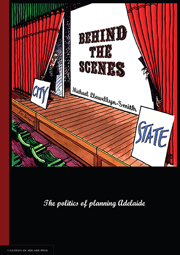Book contents
- Frontmatter
- Contents
- List of Figures and Tables
- Abbreviations
- Acknowledgements
- Foreword
- Introduction
- 1 The background to the founding of Adelaide and South Australia in 1836
- 2 The development of the City and State from 1840 until 1950 and the City/State relationship during this period
- 3 Changing attitudes to planning the City and State from 1950 until 1972
- 4 The establishment of the City of Adelaide Development Committee and the introduction of Interim Development Control
- 5 Planning in Sydney and the work of George Clarke
- 6 The City of Adelaide Planning Study
- 7 Converting the City of Adelaide Planning Study into a City Plan
- 8 An innovative system of city planning from 1 March 1977
- 9 Changes in the ACC and the State, and the first Heritage Study of the City
- 10 The operation of the City's planning system from November 1982 until May 1987
- 11 The Condous Lord Mayoralty and the declining importance of the City of Adelaide Planning Commission
- 12 The State Planning Review, the last City Plan and the end of the City's separate system
- Conclusion
- Appendix 1 Key People of Influence identified as potential interviewees
- Appendix 2 Heritage Summary Assessment Sheet
- Bibliography
- Index
12 - The State Planning Review, the last City Plan and the end of the City's separate system
Published online by Cambridge University Press: 05 June 2013
- Frontmatter
- Contents
- List of Figures and Tables
- Abbreviations
- Acknowledgements
- Foreword
- Introduction
- 1 The background to the founding of Adelaide and South Australia in 1836
- 2 The development of the City and State from 1840 until 1950 and the City/State relationship during this period
- 3 Changing attitudes to planning the City and State from 1950 until 1972
- 4 The establishment of the City of Adelaide Development Committee and the introduction of Interim Development Control
- 5 Planning in Sydney and the work of George Clarke
- 6 The City of Adelaide Planning Study
- 7 Converting the City of Adelaide Planning Study into a City Plan
- 8 An innovative system of city planning from 1 March 1977
- 9 Changes in the ACC and the State, and the first Heritage Study of the City
- 10 The operation of the City's planning system from November 1982 until May 1987
- 11 The Condous Lord Mayoralty and the declining importance of the City of Adelaide Planning Commission
- 12 The State Planning Review, the last City Plan and the end of the City's separate system
- Conclusion
- Appendix 1 Key People of Influence identified as potential interviewees
- Appendix 2 Heritage Summary Assessment Sheet
- Bibliography
- Index
Summary
THE STATE PLANNING REVIEW
Premier John Bannon was influential in the development of the State during the 1980s. He combined the Savings Bank of South Australia (founded in 1848) and the State Bank of South Australia (founded in 1896) to form the new State Bank and this was part of a substantial period of expansion in Adelaide. Bannon also created the South Australian Finance Authority to assist the private sector with developments. Further, he brought about the ASER development, despite opposition from the ACC, and in 1985 secured the Grand Prix motor race for Adelaide with the support of the ACC.
However, by the late 1980s there was mounting public criticism that the Bannon Labor Government was failing to deliver major projects. There was a community feeling that the planning system was to blame and the Government believed the existing planning system did not serve the community well. The problem was the philosophy of control behind the City of Adelaide Development Control Act 1976 and the Planning Act 1982. There had been a perception in the 1960s and 1970s that government under Dunstan's influence could bring about change and achieve reform through legislation. This attitude had changed and Greg Crafter observed that what was needed was legislation with some vision that empowered communities and facilitated rather than controlled development.
- Type
- Chapter
- Information
- Behind the ScenesThe politics of planning Adelaide, pp. 309 - 332Publisher: The University of Adelaide PressPrint publication year: 2012



